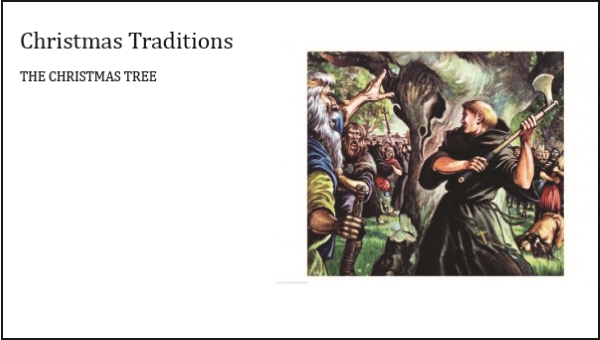By Tyson Thorne

Legend has it the origins of the Christmas Tree tradition begins nearly 1,300 years ago in central Germany. Before we get there, however, we must start our story a few decades earlier in a British manor outside London, England. Young Winfrid, against the objection of his parents, entered a Benedictine monastery where he studied the Scriptures and grew in intellect, holiness and piety. After reading of the adventures of monks who had brought Christianity to his island home a century before, Winfrid longed to become a missionary himself. He journeyed to Rome to obtain the permission of Pope Gregory II. So delighted was the Pope with the young man’s fire for the gospel, he not only granted Winfrid his permission, but changed his name as well to the better known Boniface.
In 721 AD Boniface travelled through central Germany spreading the gospel in a way so systematic and so successfully that his efforts quickly became compared to that of the apostle Paul. There was one group Boniface was unable to crack, however, a cult of the god Thor in the village of Geismar. Their practices were particularly savage and centered around a great old oak tree. Every winter the village would gather and a child was sacrificed to Thor, killed and bled at the base of the tree. The oak had existed for centuries, likely even before the land was settled. It was a permanent fixture and was believed to have been protected by the thunder god himself. Not only did the people reject the message Boniface had brought, but they boasted that their mighty oak would outlive the gospel itself.
He never forgot that village destined for the retribution of God and yearned to return to them a second time, which he did years later. He brought with him fellow missionaries and they travelled with merriment and boldness, but upon arriving at the village the courage of the other members of his team failed. Learning of the human sacrifice that was about to be made, they feared for their own lives. Boniface turned to each man and proclaimed to them all, “Here is the Thunder Oak, and here the cross of Christ shall break the hammer of Thor!”
The followers of Thor were amused by the display, but their amusement turned to shock as Boniface picked up an axe and quickly felled the ancient oak. None could believe their eyes, but they believed their ears when they heard Boniface preach to them. In the manner of Paul who used an alter to an unknown god in Athens, Boniface pointed to a young sapling evergreen now visible behind the stump of the Thunder Oak. He said,
This little tree, a young child of the forest, shall be your holy tree tonight. It is the wood of peace… It is the sign of an endless life, for its leaves are ever green. See how it points upward to heaven. Let this be called the tree of the Christ-child; gather about it, not in the wild wood, but in your own homes; there it will shelter no deeds of blood, but loving gifts and rites of kindness.
The people heard, the people believed and the people were baptized.
That is one account of the origin of the Christmas tree, but there is yet another. It too takes place in Germany but several hundred years later, circa 1500. One Christmas Eve the reformer Martin Luther was walking to his home through the forest and was momentarily struck by the beauty of a copse of evergreens lightly dusted in snow. In the moonlight they appeared to shimmer and glow with the holiness of the season. Once home Martin had made a plan, and chopped down a small fir tree and took it inside to share the story with his children. As they were celebrating the birth of the savior, he thought it appropriate to decorate the tree with candles.
Which story is true? Perhaps both; perhaps neither. The tradition of the tree does appear to stem from Germany, however, and was most likely brought to America from German immigrants at the time of the American Revolution. It remained a very small tradition among the German-American population up until 1851 when Christmas trees made their way to New York City. 50 years later 20 percent of America had adopted the tradition, and 20 years after that it was nearly a universal custom.
|
|
|
